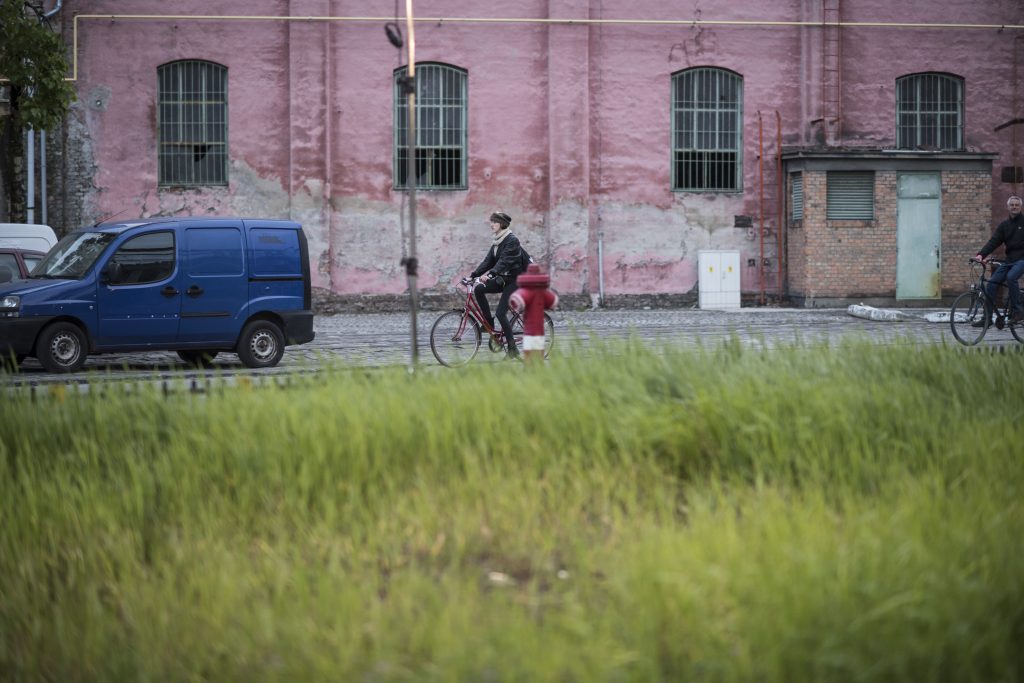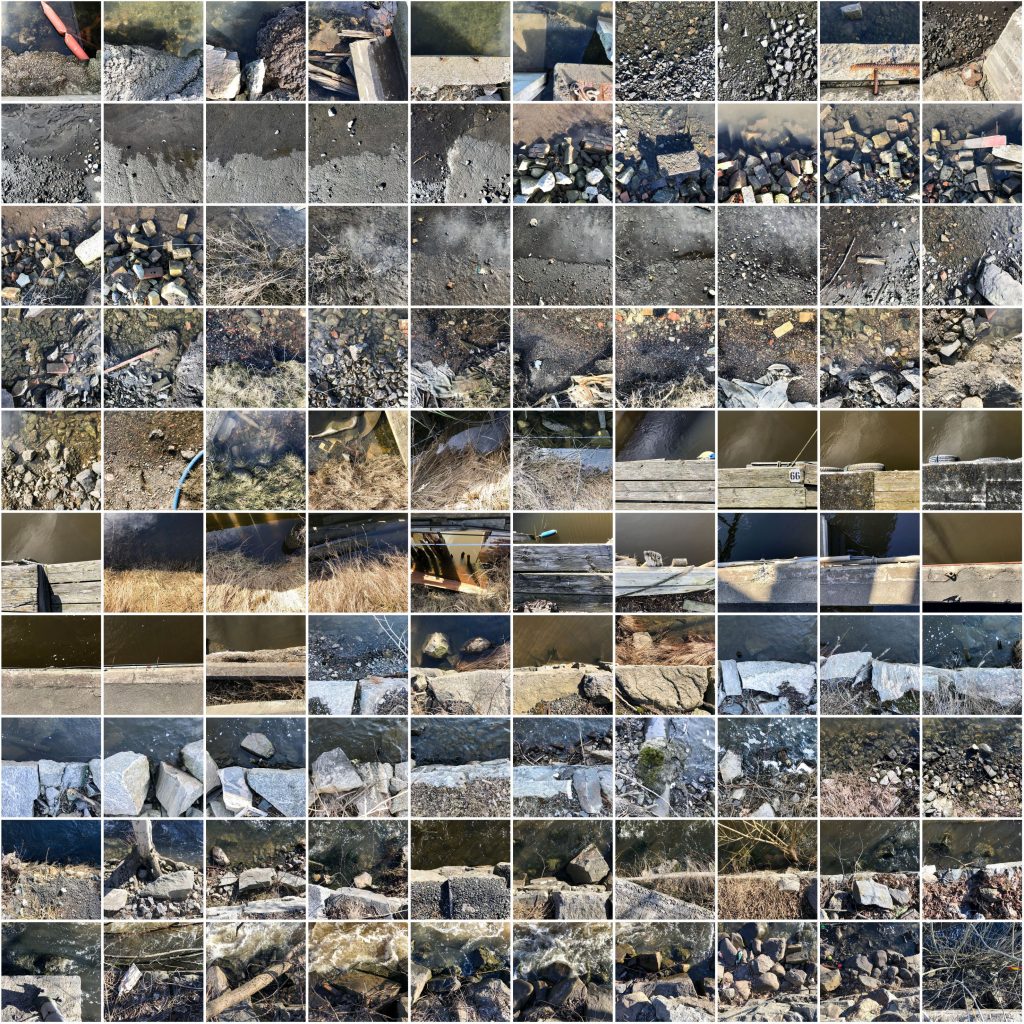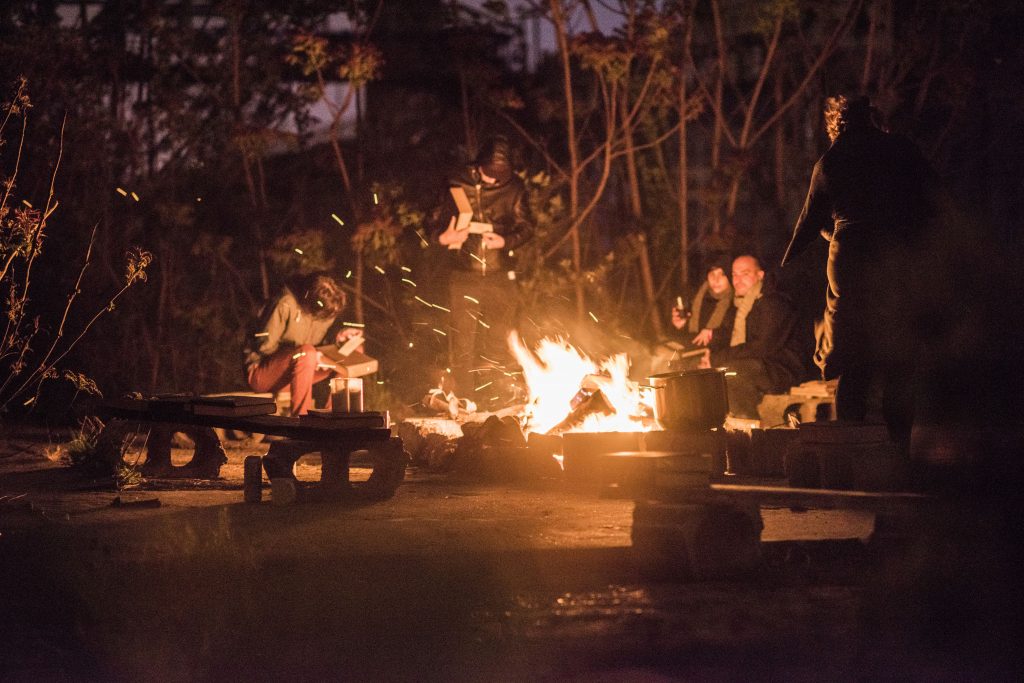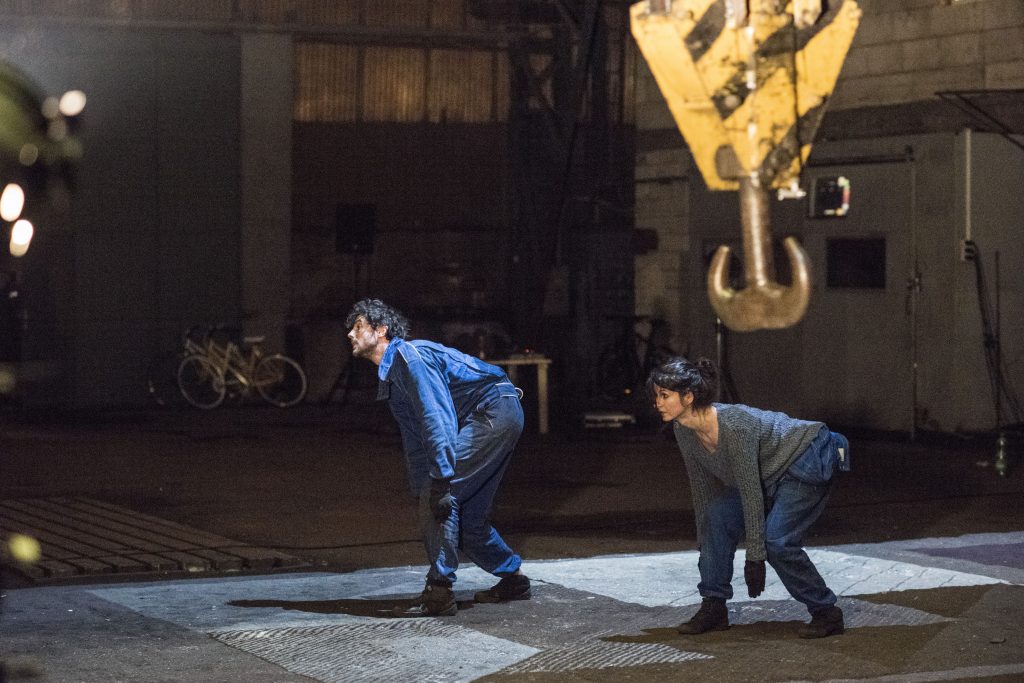A story of rivers, time and interventions in post-industrial spaces

I am on a bike ride through the cobblestone streets of Csepel Művek, the partly abandoned industrial park just south of central Budapest. It is a late afternoon in April; the sun is about to set, making the old brick buildings and tall chimneys glow in reddish brown. I am following closely behind David Somló as part of his bicycle-sound-tour Horizon. It is just the two of us. I have two small portable loudspeakers attached to my body, one on my belly and one on my back, but there is no sound coming from them yet. We ride in silence through narrow passageways and along some dirt roads, past warehouses and old foundries, rusty iron gates and factories with broken glass windows, worn down residential buildings, and here and there some piles of rubbish. I remember from David’s presentation in Moss a few weeks earlier that one is not supposed to initiate any conversation or make any kind of unauthorized noise while attending his sound tours. After a while I start to notice the sounds around us, the wind through the trees, birdsong, and the distant thump of heavy machinery. We make a short stop beside a big industrial fan, just listening to its loud mechanical noise. Further down the road I get a bit upset by two dogs coming at us, barking aggressively from behind a fence. I start to think that the loudspeakers are just a trick to make me become more aware of the sounds from the surroundings, which may be a nice enough idea. After a while, though, I start to notice another sound that doesn’t seem like it’s coming from the wind or the trees or the factories; a slowly rising, ambient tune that appear to be following us. I have by now forgotten all about the loudspeakers, it’s been maybe 20 minutes, or half an hour, and I’ve fallen into the slow, dreamlike rhythm of the shifting sounds and the soothing movements of the bike. The new sonic element intensifies the intimacy and subtle drama of the situation. I feel nostalgic, almost romantic, as if I’m in a movie from the 1960s, La Nouvelle Vague-style (I’m later informed that the “cinematic” feeling wasn’t all that wrong, but that the inspiration for the work came from Andrei Tarkovsky’s sci-fi classic Stalker, with Csepel, probably, as the mysterious and ambiguous “Zone”, something which of course makes a lot more sense). David makes a careful gesture with his arm, pointing left, and we turn toward an open plain and stops in front of the Danube. A panoramic view of one of the biggest waterways in Europe is all of a sudden in front of me. The movie goes into widescreen for a grand finale, as the last rays of sunlight glimmer in the slow waters of the river.
Horizon was part of the PICTURE Budapest-Østfold that took place in the former industrial cities Moss and Fredrikstad in Østfold and in Csepel over a few weeks in late winter and spring 2017. The project’s goal was to do artistic research and investigations of public space in post-industrial environments. Intended as an open-ended undertaking, the aim was not necessarily to produce finished works of art, but make experiments and interventions that could shed some light upon, or offer alternative understandings of, current processes in city planning in times of fundamental change. The specific sites for the project were closed down and emptied factory buildings, dry docks, and shipyards that could offer an aesthetic and material/architectural backdrop for intuitive artistic views on post-industrialism; what it is, how it can be understood, and what significance it has for our future lives.
It is a grand theme. In its strictest, sociological sense, post-industrial society is defined as “the stage of society’s development when the service sector generates more wealth than the manufacturing sector of the economy”. (Wikipedia) But the possible outcome of this time and age is saturated with perspectives and scenarios of both utopian and dystopian nature. It is in many ways one of society’s most urgent issues, as it connects to economic, political, social, environmental and existential aspects of our global present, past and future – from enormous technological progress and freedom, from manual and often dangerous labor on one side, to unemployment due to automation and outsourcing, escalating income inequality, the rise of nationalist, populist and neoliberal politics, the crumbling away of progressive Enlightenment values, and the threat of ecological collapse on the other. In this context, artists can of course do very little. Art cannot change the world; it doesn’t solve any social problems or stop famine. But it can change the way we perceive the world, and, in the case of the PICTURE Budapest – Østfold, how we interpret the physical remains of the age of industry, optimism and unimpeded pollution. As David Somló’s meandering sound-tour so beautifully and generously demonstrated to me, a couple of bicycles and a careful gesture with an arm can be sufficient to unfold a story of both poetic and epic proportions.
The PICTURE Budapest – Østfold is, in fact, as much about small findings among grass and leaves as it connects to the full extent of the history of civilization. It is about modern ruins, urban re-development and property investment, as well as fundamental differences in the social and political history of two nations on the same continent. It is about sudden, spontaneous interventions in public space as well as being a large-scale experiment within the discourse of site-specific art. It is about loss and nostalgia, as well as opportunities and prospects for future generations. It is also a story about rivers, and the floating of time.
Future paths
The two rivers in question could hardly be more different. Mosseelva (the Moss River) that flows through Møllebyen (whose name means “Mill Town”) is no more than a stream compared to the Danube. But it is as fundamental to the history of Moss, as the “River of Kings” has been to the many towns and cities along its banks, including the capital of Hungary.
A few weeks previous to my bike ride through Csepel I’m strolling slowly along the short stretch of ragged land, overgrown parking lots and half-rotten remains of a wooden pier at the narrow outlet of Mosseelva. It is the site of choice for Jakob Oredsson, for his research during the first phase of PICTURE Budapest – Østfold. I’m talking to Jakob about the river and its significance for the people and history of Moss, and his cooperation with Mossefossens venner (Friends of the Moss Waterfall), a volunteer group that is promoting the waterfall’s significance as the “cradle of Moss” and supporting the rehabilitation of the old waterworks, as well as cooperating with the city administration and private housing developers about the redevelopment of the Verket industrial area. Jakob shows me some peculiar small rocks that he has found during his fieldwork. They are irregularly shaped, surprisingly lightweight – close to weightless – with a smooth, dense surface, much like plastic. The colour mostly goes from deep blue to greyish or light blue, with swirls and veins that make them look like some kind of hitherto unknown marble. Some are uniform in colour, opaque black or almost transparent yellow, as if they were different types of gemstones, like amber or topaz. Some seem to be conglomeratic and multi-composite, a mix of smooth perfection melted together with lumps of sand or old remains of concrete in an unknown process. The rocks appear as both natural and artificial, something recognizable but still alien, as if some other force than nature put them there. But who, and how?
We never solved the mystery. In later correspondence we just referred to them as “the post-industrial stones”. The area where they were found was until recently a site for heavy industry, with the now abandoned Peterson AS sulphite pulp mill and paper factory as its centre. Were they by-products or residue from the paper production? Some kind of molten, densely compressed asphalt, or the result of some ceramic processes that we don’t know about? It is doubtful that they can be any kind of natural rock, as they would be highly anomalous for the region’s geology – or any geology for that matter.
The rocks were initially not a vital part of Jakob’s work in Moss. His project, titled Future Path, dealt with present and future prospects of the Verket area, where the former manufacturing structures are being torn down and removed, or redeveloped into housing projects. Within a decade or two, thousands of people will be living in the planned residential complexes, the first were being prepared for construction just as the PICTURE Budapest – Østfold’s initial phase took place in February 2017. As part of his research, Jakob had marked up with bright orange sticks the future border between public space and private property on the southernmost edge of the plot of land in question. The sticks delineated a narrow strip on the riverside where one now could easily imagine the future five, eight or even ten story concrete buildings and their balconies towering over our heads and the river. As a conclusion of his investigations, Jakob invited to a public walk along this “future path” that ended in a marshland where Mosseelva meets the sea, an area that much like the rocks defies categorization; a mix of post-industrial, urban wasteland and a seemingly natural habitat for birds and wild plants. Is it an old landfill? Has it been exposed to decades of industrial pollution? Will it be exploited for commercial use? Or can it become a public park or nature reserve where animal life can thrive, and children may play safely sometime in the near future? Jakob’s intervention was a gentle activation of the space – “to be here is already to change it”, as he himself explained during the walk. Our presence could well be the spark that activates a larger chain of events within the public and political system, for the benefit of future Verket inhabitants; an example of public involvement and participation that is so fundamental for the maintenance of our precious democracy.

The burden of industrialism
For the present moment, the “post-industrial stones” are the most tangible “product” of Jakob’s work in Moss. Unintended as they may be as part of the PICTURE Budapest – Østfold’s artistic endeavours, they might still turn out as an ambiguous treasure, or fateful evidence, that can tell a story both grander and darker than that of any public space-private property ratio. A reasonable guess is that they really are pieces of molten plastic; residue from the former manufacturing processes melted and seeped into the ground. As such, they can be seen as material representations of the transition from industrialism to the post-industrial age. In an even larger perspective the rocks are intertwined with processes that profoundly transcend any sociological perspective on industrial and post-industrial society. Plastic is a true product of industrialism, as a physical substance as well as being the most widely distributed and applied material in modern mass commodity production, used in anything from spaceships and pacemakers, to sneakers, kitchenware and contraceptives. Plastic has helped bring tremendous wealth and fundamental social change to the industrialized world. But it is also one of the most widespread and recalcitrant pollutants on the planet. Since the day it was introduced as a commercial product a little over a hundred years ago, plastic waste has spread to every corner on Earth, and it doesn’t go away. It does not biodegrade under most conditions, and will hence stay with us “in perpetuity”.
Plastic has, in fact, been found to be forming a new kind of rock. The Geological Society of America has approved the name plastiglomerate to describe a “hybrid” material resulting from the fusion of plastic debris with natural materials such as lava, wood, metal, sand, and marine corals.[1] Our “post-industrial stones”, or plastiglomerates as we now may call them, thus become a modest indicator for something bigger. As has been pointed out in recent years, and for reasons mentioned above, plastic (and plastiglomerate[2]) is one of the markers of what is known as the Anthropocene, the proposed geologic era where industrial civilization has changed the planet in a scale comparable with geologic processes. The notion of the Anthropocene is admittedly controversial, and its definition is likewise contested. Some trace its beginning back thousands of years, to the first developments of agriculture and the shift away from hunter-gatherer cultures. But most see the Industrial Revolution in the 1800s, and its consequence for the consumer culture in the 20th century, as the definitive starting point. No matter how we define it, the implications of these factors are profoundly connected to our present and future times, and the state of the Earth and the soil and the waters of oceans and rivers that we are so dependent upon. Post-industrialism is thus entangled with the concept of the Anthropocene, in my view a recognition that accentuates the PICTURE Budapest – Østfold’s profound significance. The political and environmental challenge the global community is facing the next few decades is a disaster in the making. In such a dystopian perspective, the ramshackle factories in Csepel and the quiet void of the production halls in Verket become not so much a promise for future capital investments and economic growth, as a dire warning of what lies ahead for the human race.
Dreams, fears and hopes
The various artistic proposals address this fact in both abstract and utopian ways. In their small booklet produced for the final presentation in Csepel, Liv Kristin Holmberg and Camilla Wexels Riser proposes the empty factory building as “an imaginary ruin”, and writes: “We wish to create a space in the post-industrial linked [to the] cycle of the sun.”

They quite simply invited me to share an hour of joint silence around a bonfire in the twilight – the blue hour, as they called it – in the midst of the silent silhouettes of abandoned workplaces and ever more distant memories, which made these brutal surroundings take on an almost sacred quality. In addition to this relational approach they lighted a small area in the dark and dank basement of the Peterson pulp mill with theatrical blue light that made the solid concrete structures, pillars and broken columns appear as an archaic, age-old ritual site. The simple gesture made a profound connection to both pre-historic and post-industrial times, the unforeseeable future and the millennium old age of rocks and rivers, and offered a sublime perspective on human existence as enfolded in geologic time, deep time – the immense arc of non-human history that shaped the physical world.
A more confrontational moment was offered by the dance group Ziggurat Project (Máté Czakó, Flóra Eszter Sarlós, Kristóf Szabó) at the same premises, in their work_in_process in which the movements of the former machinery and the routinely movements of the factory workers was meticulously replicated in a captivating performance. The choreography ambiguously showed, as I perceived it, the human as fragile and cowed by the mechanical environment, and simultaneously as the mastermind and sovereign of the very same environment. The paradox of industrial and technological modernity revealed itself in this battle between synchronized bodies, flickering video images, and industrial architecture. It is of course possible to imagine a similar face-off transferred to post-industrial life, where the hi-tech tools and online connectivity of the digital working class – who in many cases experience working conditions as exploitative and suppressive as the industrial factory worker’s – have replaced manual labor and mechanical machinery.

Dire times call for optimism and utopian thinking, and not least communication, interaction and public engagement. These are the pillars of any democracy. With Jakob Oredsson’s cooperation with the Mossefossens venner group already mentioned, several projects dealt specifically with the involvement of local communities in search for ideas, opinions, dreams, fears and hopes for the future city. Edit Vizer and Naja Lee Jensen both met people and conducted interviews, and went for “walks and talks” to recreate history through physical presence – as Edit coined it: “body storming”. Or, as in Naja’s case, invited to a moment of intimate sharing in a small rowboat on the Glomma River – yet another river relevant to the PICTURE Budapest-Østfold story – that flows through Fredrikstad, all in the search for possible utopian visions and “what-if scenarios” in the various local contexts. Such community-based approaches to site specific artistic work has the potential of laying the ground for a more playful engagement in democratic processes, through body movement and a bit of adventure – Naja even invited for a night out camping. Her project Drømmefabrikken I and II (Dream Factory) involved, among other things, sleeping in a tent for one night in the huge, closed-off shipyards of the Fredrikstad Mekaniske Verksted. The idea was to emphasize the gap between what actually took place in the heyday of industry, and the near impossibility for the “post-industrial generations” to fully comprehend what these sites really were – how they operated, and what it meant for the workers. This part of Naja’s project was an invitation to get a bit lost at the site and at the same time open up for a metaphysical experience through a bodily exposed, and for some maybe also a bit scary experience.
Children in utopia
The utopian quality of social actions like these lies in the belief that the people, as individuals and as a group with common interests, can influence the processes that are determinative for our future. With that in mind, what can be more utopian and positively determinative than our children, the future generations? Jonas Bjerketvedt’s video/sound installation Purpose of Shaping in Csepel portrayed five young girls in traditional Hungarian clothing, performing a folk dance in slow motion. Like a melancholic ritual of mourning over bygone times, its dreamy quality, enhanced by the low resolution of the video images and the slow abstract rhythm of a simple electronic underscore, seemed oddly out of tune with the reality of life in the desolated streets outside. But rather than offering a nostalgic eye on tradition, Purpose of Shaping appeared as an insistence on the belief that even in the future we will see society, humanity, and civilization, even in grim, post-industrial places like Csepel.
In my view, this is what was also at the core of Daniel Makkai’s optimistic and quite literally playful double project Designing Our Future (Moss) and Factory Playground (Csepel), in which he engaged local children in organizing a kind of alternate reality games, or “live animated social games” as they were called here, much on their own terms, as both an emphasizing and a transformation of the realities of the various areas of Verket and Csepel. In Verket, two groups of kids acted as local “inhabitants” and “visitors”, or ”explorers” – maybe from outer space – that sometime in an unknown future search together to prepare the ground for possible new settlements in this labyrinthine and mysterious area. In Csepel, the interaction with the kids had, unsurprisingly, a darker side. Daniel made contact with the children living with their families inside the factory area, their parents either unemployed or doing low-paid work, unable to find homes elsewhere. Here, the kids made a “horror movie” about an evil spirit dwelling in the void of the factories, controlling their lives and stopping them from escaping the area, which, as an uncannily realistic consequence, was also their destiny in real life. Daniel’s project revealed the stark contrast of growing up in small-town Norway versus the harsh working class reality of Csepel Művek, where no-one, much less children, should be expected to live. But to an even larger degree, it signaled a sense of relief and heartfelt optimism. As the kids explored the post-industrial landscapes, running and flowing like small rivers through the forlorn remnants of the past, they became a metaphor for life and time itself. Like the first civilizations of an ancient past that arose from the waters of rivers, or the waterways that made the foundations for industry and progress in modern societies, the children’s life-giving presence in these circumstances became the most epic tale of all of history of mankind – that of the path of generations through the ages, and the promise of times to come.
The process is the art
Though PICTURE Budapest-Østfold was perhaps limited in scope considering the number of participating artists, the project’s thematic ambition and artistic content was, as this essay has suggested, of almost unlimited proportions. The workshops and seminars in Moss, Fredrikstad and Budapest, the social meetings and talks among the artists, and finally the concluding presentation in Csepel included everything from the very big and the very small: from memories and dust and the tiniest pieces of residue from the heydays of industry, to future changes in the earth’s stratum; from interaction with local communities and different levels of bureaucratic establishment, to confronting the challenging political situation in present day Hungary – the latter most explicitly expressed in Naja Lee Jensen’s sound-turned-poster intervention in Csepel.[3]
It is worth noting that all this took place outside of any established art institutional context, something that gave a dimension of both freedom and risk for the participating artists. Maybe that can be put forward as an ideal situation for artistic interventions at large: a combination of liberty and chance that ensures a level of dynamics, unpredictability and intuitive reactions to a situation, site or space, without the restrictions that tend do follow anticipations of specific results, physical or otherwise, within the institutional sphere. But that concern is not foreign to art in public space either. To quote renowned curator Mary Jane Jacob, whose work has been pivotal in the field of public art: A paradox regarding much public art projects is that the end result is already defined previous to the process. But “it is the process that is the art, the goal must be undefined until the work is finished, otherwise there will be no new discovery”, according to Jacob.[4] It lies in the nature of art as intervention that the more risk you take, the more uncertain the “result” will be. At the same time, as a consequence of stepping outside of the safety of the institution and into the reality of the streets, one has to face another set of challenges, be it lack of response and understanding from the very same public one is aiming to reach, or straight out hostility and censorship (as was the situation with Naja’s work in Csepel, that was promptly shut down after reactions from locals). However, such factors are outweighed by the possible and immediate relevance of artistic interventions in the public realm, as contrasted to art that is played out within the more neutral walls of the museum or gallery. Whether proposed and presented as confrontation or pleasant surprise, or both, public art/art as intervention can unveil hidden potential and create poetic moments, encourage collaboration and participation, and ask questions that others don’t ask. Public spaces are mirrors of processes taking place in societies, and art that confronts and contemplates such spaces can in turn raise awareness of those processes, and ultimately, on public and democratic engagement as the definition of society as we know it. In that perspective, the possible “result” of the PICTURE Budapest – Østfold is still an active and open process.
[1] Davis, Heather, ”When the Soul of the Earth is Made of Plastic”, in Norwegian Art Yearbook 2017. Oslo: Pax Forlag, 2017.
[2] en.wikipedia.org/wiki/Plastiglomerate
[3] For more detailed information on this and other interventions, see individual project descriptions elsewhere in this publication.
[4] Mary Jane Jacob, lecture held in Oslo June 18th, 2015.